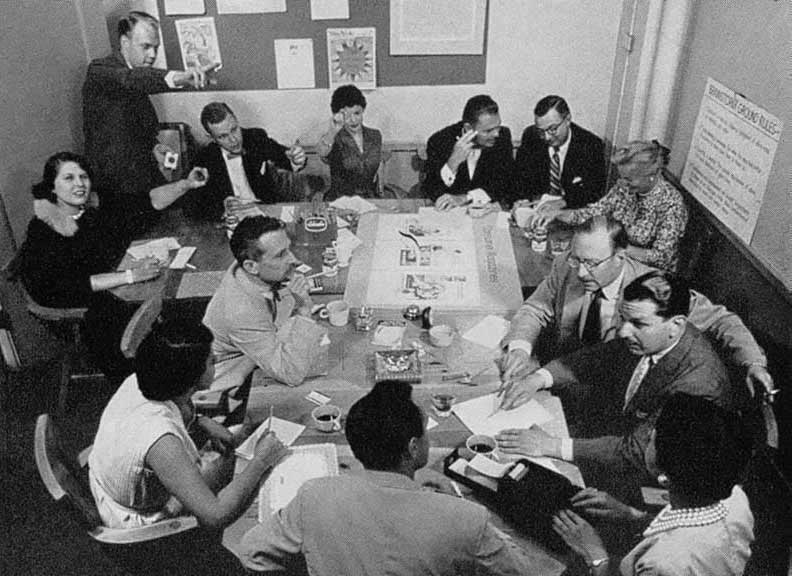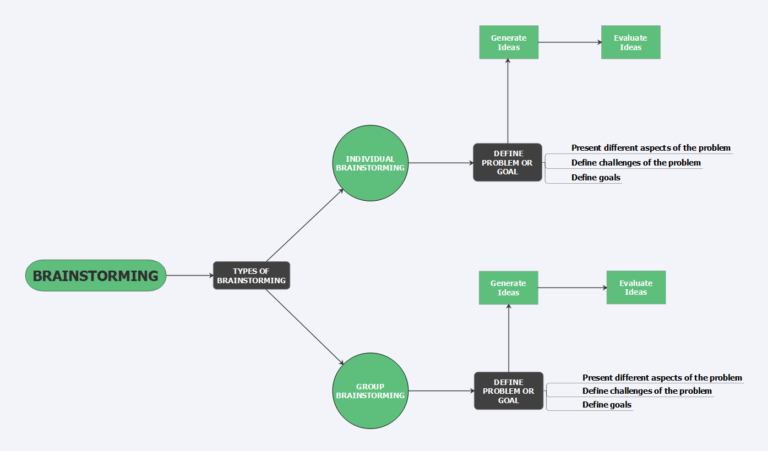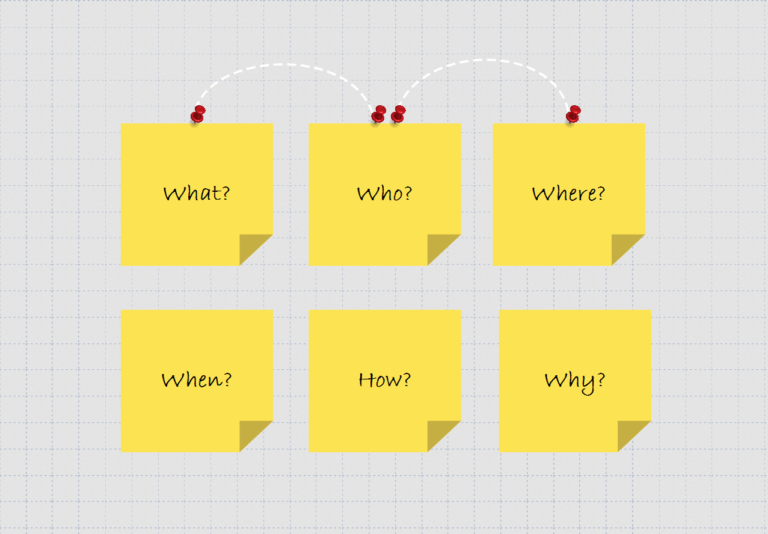WHAT IS BRAINSTORMING
AND HOW IS IT HELPFUL?
Brainstorm (n.) also brain-storm, ‘brilliant idea, mental excitement, fit of mental application,’ 1849, from brain (n.) + figurative use of storm (n.). Verbal meaning ‘make a concerted attack on a problem, involving spontaneous ideas,’ is by 1947.
Brainstorming as an idea for the first time emerged back in 1942. The term was introduced by Alex Faickney Osborn, founder and advertising executive of the US advertising agency BBDO. In fact, brainstorming was introduced as a creative technique inspired by the working atmosphere in BBDO. Namely, during his time in the company, Osborn’s observations of the everyday work in the office took him closer to developing this creative technique. He found out that during the company’s meetings and discussions, all employees were not proposing creative ideas, methods or solutions, which resulted in poor meetings’ closings.
Business meetings are supposed to be an opportunity to set goals and objectives, present and define problems, propose and discuss ideas, and in the end, work toward realizing them. Osborn was aware that the conventional business meetings he and his colleagues held didn’t include an exchange of fruitful ideas and were usually suppressing people’s spontaneity and the ability of free thinking. This inspired him to establish new basic principles of conducting effective meetings that will be based on freedom of mind and creative thinking.
The new rules that Osborn imposed were:
- Do not criticize ideas
- Encourage producing a wide array of ideas
- Build upon others’ existing ideas
- Motivate sharing wild and unconventional ideas
During the time when he made this concept, Osborn started becoming active in writing on creative thinking and in his 1942-book “How to Think Up” he introduced the activity of brainstorming. His personal interpretation of the term brainstorming was “A conference technique by which a group attempts to find a solution for a specific problem by amassing all the ideas spontaneously by its members”. From that point, the term brainstorming officially emerged and was also presented in the working environment in BBDO.
These became the fundamental rules of group brainstorm activities that took place in working environments. After BBDO’s employees were introducing them, Osborn noticed that during the meetings their minds were unblocked which resulted in presenting more innovative and useful proposals.

A brainstorming session at BBDO New York office in 1950s. Photo © Philippe Halsman
The ideas that before employees kept for themselves because of the fear of rejecting now came up to the surface. Osborn observed that people were motivated and much more creative ideas sparkled in the discussions. Employees shared their ideas regardless of what the others were thinking about them. This way, many concepts that previously could be pointed out as ‘stupid’, ‘silly’ or ‘wrong’, now have been taken into consideration and discussed. In the end, all the meetings finished on a positive note because everyone felt free to unleash its creativity.
Later on, Osborn dedicated himself to his work in writing and after more than 40 years in the advertising industry, he resigned from his position of advertising executive at BBDO.
Defining Brainstorming
Brainstorming as a technique has a creative character and it can be practiced individually or in a group.
The concept of brainstorming includes defining a simple or a complex problem for which solution are generated different ideas that are later accepted or rejected. The participants in the process of brainstorming present and reveal new ideas as potential solutions for a specific problem. In this process, brainstorming helps the stimulation of the human mind towards creative problem-solving.
Osborn’s approach to brainstorming and his few simple rules from the beginning until this moment have helped in solving many important issues. Brainstorming as a group activity has become a revolutionary technique that can find its use in both small and large enterprises regardless of the industry in which they are operating. Moreover, it can be beneficial for individuals who are in need of a solution for a specific problem.
This creative thinking technique as a group activity usually starts with a gathering of a group of people. As an informal method of problem-solving, group brainstorming stimulates creative thinking. The proposals that come up in these constructive meetings can provoke interesting and unusual ideas that later could become a creative solution to a problem.

Types of brainstorming mind map.
Finding the Right Type of Brainstorming
Group brainstorming helps people to activate their minds and think freely since during these group sessions there isn’t a criticism of ideas.
On the contrary, there is an encouragement of unconventional ideas.
In a company of any scale, team brainstorming that includes a group of six to eight people is optimal for generating quality ideas and proposals. A variety of studies have shown that when people brainstorm together, they spontaneously exchange ideas that tend to grow and converge.
It is important to emphasize that during the stage of proposing and generating ideas people shouldn’t criticize and discourage proposals that are based on thinking that is different from their perspective. Additionally, each member of the team should also avoid rewarding ideas that they consider to be standing out. This way they will stay away from judgment and will open possibilities for effective idea generation. At the end of the brainstorming session, every idea should be analyzed and evaluated so that solutions could be discovered.
Group brainstorming sessions can be informal, which means that there may not be a person at the position of a discussion leader.
However, in most companies where this activity is practiced there is one facilitator who conducts the discussion in order to ease the process and lead the people in the right direction so that more ideas surface.
Individual brainstorming, on the opposite, involves storming by yourself.
The difference between group and individual brainstorming is that they take different approaches, which can have different outcomes. It is known that individual brainstorming can stimulate the production of a wider and better array of ideas. This happens because some people due to numerous reasons may experience blocking while participating in a group brainstorming.
Depending on one’s individual character and point of openness while participating in team activities, some people could have a problem presenting their ideas in front of a big group. In contrast, during individual brainstorming, they could inspire themselves to explore different ways of generating creative ideas.

For some, Individual brainstorming can stimulate the genetarion of more creative ideas.
When you are on your own, you may feel more flexible and comfortable to reveal to yourself as many unconventional ideas as possible because you won’t have to think about other’s views and judgments. But nonetheless, when people practice individual brainstorming they don’t have the possibility to learn from other’s experiences and expertise, as well as to absorb their ideas that could help them in developing their own.
In the end, it could be concluded that both types of brainstorming have advantages and disadvantages. While group brainstorming can sometimes cause a blockage in those who prefer the individualistic approach in resolving problems and achieving objectives, individual brainstorming could limit the creative thinking in those who are more inclined towards team collaboration.
Choosing Brainstorming Over Other Techniques
Aside from brainstorming, there are numerous problem-solving and goal-achieving strategies and techniques among which the most used are ‘Abstraction’, ‘Analogy’, ‘Divide and Conquer’, ‘Hypothesis testing’, ‘Lateral thinking’, ‘Means-end analysis’, ‘Method of focal objects’, ‘Morphological analysis’, ‘Proof’, ‘Reduction’, ‘Research’, ‘Root cause analysis’ and ‘Trial-and-error’.
Several factors can influence one’s decision to choose brainstorming over all other strategies. The most important characteristic of brainstorming is that it is defined as a creative activity that encourages creative thinking from all participants. On the other side, other brainstorming techniques can limit this process and result with presenting uninspiring solutions and ideas.
Compared to different techniques, brainstorming includes the following phases: presentation and definition of a central problem or a goal, generation of ideas, discussion of the produced ideas, and final evaluation of the presented ideas. This activity allows the creation of an open and relaxed atmosphere that stimulates everyone’s participation. It creates an environment in which people feel comfortable enough to share their opinion and point of view. When you are brainstorming by yourself or in a group, you can easily find practical solutions to the issues you are encountering.
Brainstorming sessions can break out the conventional exchange of views because it motivates sharing extraordinary ideas. Additionally, the process expands the human creative horizon and it’s fun because people can enjoy in an open-ended search for new ideas.
Group brainstorming can also be beneficial for establishing closer and effective relationship with colleagues and superiors. When exchanging different ideas, people have the possibility to hear others’ opinions and points of view, which can incite discussions that could lead to the perfect solution. In the meantime, during these discussions, people could get to know each other’s characters better. It is proved that people tend to get more anxious when they have to contribute to a group where a person in a superior position is present. Therefore, during the discussion stage where the environment starts to become relaxed and everyone shares their ideas, eventually those who are more apprehensive will loosen up and join the group.
Bringing Out The Best in Brainstorming
Brainstorming can be conducted in three phases, which are a presentation of a problem or objective, generation of ideas and evaluation of ideas phase. However, apart from the basic principles of brainstorming which Osborn had determined back in 1942, with time, numerous strategies have evolved and proved themselves helpful for bringing out the best throughout this creative process.
These three strategies intertwined with the four basic rules can bring significantly good results in brainstorming.
Setting the right tone of the room
Presenting the problem/goal as a challenge question
Sometimes posing challenging questions when defining the focus problem and/or objective of the brainstorming session can be extremely helpful. People tend to get distracted from the main focus when are not introduced to the main problem that needs solving. To avoid this, at the beginning of the brainstorming session, be that group or individual, the problem or the goal needs to be defined but in a way that will make them stay imprinted on participants’ mind. This is possible if the person who guides the discussion presents the problem or the objective as a challenging question that will engage everyone to actively participate in the discussion.

The atmosphere in the room can impact the overall brainstorming session.
Smart ranking of ideas
Using Brainstorming in the Real World
Brainstorming is an activity that could be extremely revitalizing for the brain. It breaks the traditional and conventional thinking and boosts fresh ideas. As a group or individual activity, brainstorming can find its use in many industries and departments.
Regardless of the industry, the process of brainstorming starts with defining the problem and/or the goal of the project.
Content Writing

Marketing

Studying

iMindQ as a Brainstorming Tool
The key to productive brainstorming isn’t just following the basic rules and strategies. Good brainstorming requires more than a traditional group and individual brainstorming where participants generate their own and build upon other’s ideas.
Brainstorming can be accompanied by different tools that allow planning, analyzing and tracking the progress of presented ideas. Called brainstorming and mind mapping tools, these can help the entire process of brainstorming in a group or on your own.
iMindQ is a mind mapping tool that finds a great use in brainstorming. It is developed with the purpose to simplify the process of generating and organizing ideas and thoughts visually. As an easy-to-use brainstorming software, it allows users to create mind maps using visual diagrams for connecting topics, ideas, and information.
When it comes to group brainstorming, this user-friendly tool is practical and useful because with it, one team can avoid organizing its ideas on paper and get a clear overview of everyone’s proposals. In team brainstorming, the moderator who leads the session with iMindQ will make a map of the focus goal and all presented ideas. This is a great way of organizing the brainstorming session since it allows participants to connect and interlink ideas visually which can stimulate creative instead of linear thinking. The created map will be later discussed and analyzed between team members, and in the end, all ideas will be evaluated so that an optimal solution is chosen.

This brainstorming template can help you in the process of brainstorming in a group or on your own.
As a tool for individual brainstorming, iMindQ could help manage concepts in a more structured way than just writing them on paper and taking notes. Brainstorming maps could be a great kickstart for the brain. With them, users can get a more organized view of their generated ideas and inspire themselves to produce more. Mind maps are created with a central topic as a tree that braches out in subtopics that can be limitless.
A variety of mind mapping templates are available for both teams and individuals who participate in brainstorming sessions at work or at home. In mind mapping there are no limits to the ideas and thoughts that you can have on your mind.
Finally mind mapping as an activity can stimulate your creative thinking and give you the opportunity to solve problems more effectively.
